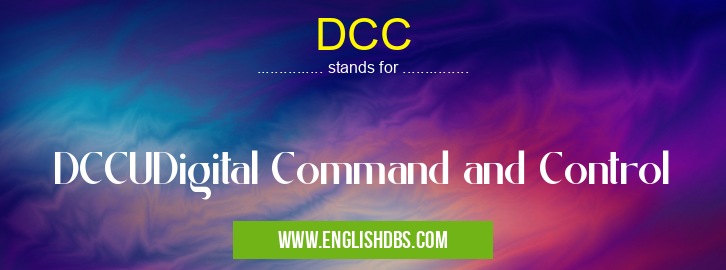What does DCC mean in UNCLASSIFIED
DCC stands for DCCUDigital Command and Control. It is a protocol and set of standards used in model railroading to control trains and accessories digitally. DCC allows for more precise and versatile control over model trains than traditional analog systems.

DCC meaning in Unclassified in Miscellaneous
DCC mostly used in an acronym Unclassified in Category Miscellaneous that means DCCUDigital Command and Control
Shorthand: DCC,
Full Form: DCCUDigital Command and Control
For more information of "DCCUDigital Command and Control", see the section below.
How Does DCC Work
- DCC systems use a digital signal to transmit commands from a controller to a decoder installed in each locomotive or accessory.
- The decoder interprets the commands and controls the locomotive's speed, direction, lighting, and other functions.
- DCC systems typically operate on a 12-15 volt alternating current (AC) track power supply.
Benefits of DCC
- Precise Control: DCC provides fine-tuned control over locomotive speed and direction, allowing for smooth and realistic operation.
- Multiple Train Control: Multiple trains can be operated independently on the same layout using DCC.
- Accessory Control: DCC can also control turnouts, signals, and other accessories, adding to the realism of a model railroad.
- Sound Effects: Some DCC decoders include the ability to play realistic train sound effects.
- Programming: DCC decoders can be programmed to customize locomotive performance, including speed profiles, lighting, and other features.
Essential Questions and Answers on DCCUDigital Command and Control in "MISCELLANEOUS»UNFILED"
What is DCC (Digital Command and Control)?
DCC is a digital control system used in model railways to operate locomotives and other accessories. It allows multiple users to control trains simultaneously on the same track layout, offering advanced features such as speed control, lighting, and sound effects.
How does DCC work?
DCC uses a digital signal transmitted through the rails to control locomotives and accessories. The signal contains information such as the locomotive's address, speed, and function commands. Decoders installed in the locomotives receive and interpret these signals, enabling them to respond to commands.
What are the advantages of using DCC?
DCC offers several advantages over traditional analog control systems:
- Advanced control: Allows for precise speed control, lighting effects, and sound effects.
- Multiple users: Enables simultaneous operation by multiple users on the same layout.
- Flexibility: Supports a wide range of locomotives and accessories, including different scales and manufacturers.
- Reliability: Digital signals are less susceptible to noise and interference than analog signals.
How do I get started with DCC?
To implement DCC on a model railway, you will need the following components:
- DCC command station: Generates and transmits the digital signal.
- Decoders: Installed in locomotives and accessories to receive and interpret the digital signal.
- Track power: Provides power to the rails and transmits the DCC signal.
- Handheld controllers or software: Used to send commands to the locomotives and accessories.
What are the different DCC standards?
There are two main DCC standards:
- NMRA (National Model Railroad Association) DCC: The most common standard used in North America.
- S88: A European standard for connecting and controlling accessories.
- DCC++: An open-source DCC standard that is gaining popularity due to its flexibility and low cost.
Final Words: DCC has revolutionized model railroading, providing unparalleled control and versatility. Its benefits have made it the preferred choice for many hobbyists seeking a more realistic and enjoyable experience. Whether you're a seasoned enthusiast or just starting out, embracing DCC can elevate your model railroading adventures to new heights.
DCC also stands for: |
|
| All stands for DCC |
